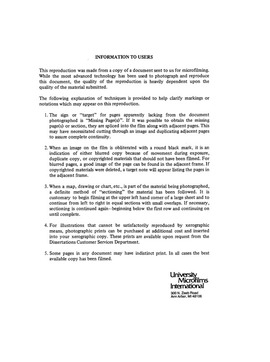| dc.contributor.author | Diba, Massoumeh Metghalchi, | en_US |
| dc.date.accessioned | 2013-08-16T12:29:21Z | |
| dc.date.available | 2013-08-16T12:29:21Z | |
| dc.date.issued | 1985 | en_US |
| dc.identifier.uri | https://hdl.handle.net/11244/5335 | |
| dc.description.abstract | Taken together, these results suggest that women who drop out of the labor force to raise families cannot expect to earn as much when they return as persons with uninterrupted careers. (Abstract shortened with permission of author.) | en_US |
| dc.description.abstract | A dynamic model based on human capital theory was formulated. The model analyzes wages and participation jointly with special attention to heterogeneity and selectivity bias. The model was then estimated using 12 years of longitudinal data from the mature women cohort of the National Longitudinal Survey and only married women were included. This is a sample of 5,083 women who in 1967 were 30 to 44 years of age. | en_US |
| dc.description.abstract | Women have a tendency to interrupt their careers with periods of time spent out of the labor force. Their labor force participation decisions are based on a comparison of the costs and benefits of market work with non-market work. The interruption would normally reduce the earning ability and thus the future participation of the individuals. The objective of this research is to estimate the effect of interruption on earning and labor force participation of married women. Previous research findings do not provide an accurate estimate because of selectivity bias, heterogeneity and not treating wages and participation simultaneously. | en_US |
| dc.description.abstract | When the model was implemented the following results were obtained: (1) Women who have spent more time at home in the past are more likely to remain in the home in the future. (2) The presence of preschool children decreases while the presence of older children increases the probability of a woman working. (3) Although part-time work carries with it fewer opportunities for advancement than full-time, it is a substitute for full withdrawal from the labor force. (4) Nonwhite workers have a higher tendency to have irregular employment patterns than the white ones. (5) Women facing larger penalties for their interruption will tend to shorten the length of their time out of the labor force. (6) It was estimated that the long-run wage loss was in the neighborhood of 9 to 10 percent for each year of work. | en_US |
| dc.format.extent | ix, 143 leaves : | en_US |
| dc.publisher | The University of Oklahoma. | en_US |
| dc.subject | Women Employment. | en_US |
| dc.subject | Economics, Labor. | en_US |
| dc.subject | Wages Women. | en_US |
| dc.title | The effect of interruption on earning and labor force participation of married women / | en_US |
| dc.type | Thesis | en_US |
| dc.thesis.degree | Ph.D. | en_US |
| dc.note | Source: Dissertation Abstracts International, Volume: 46-10, Section: A, page: 3118. | en_US |
| ou.identifier | (UMI)AAI8521269 | en_US |
| ou.group | Other | |
